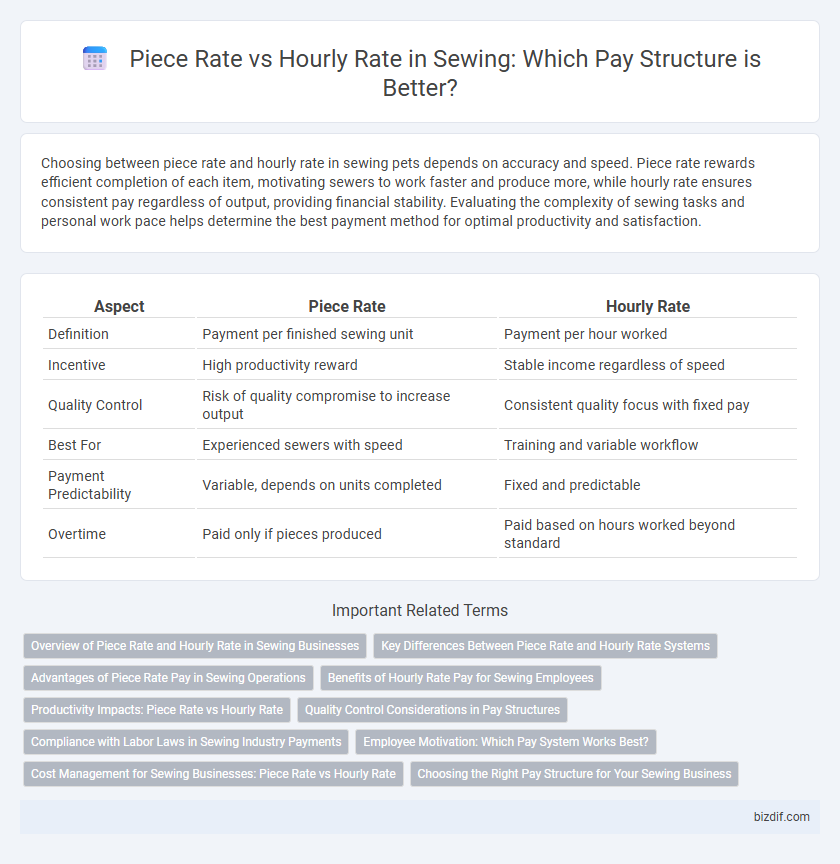Choosing between piece rate and hourly rate in sewing pets depends on accuracy and speed. Piece rate rewards efficient completion of each item, motivating sewers to work faster and produce more, while hourly rate ensures consistent pay regardless of output, providing financial stability. Evaluating the complexity of sewing tasks and personal work pace helps determine the best payment method for optimal productivity and satisfaction.
Table of Comparison
| Aspect | Piece Rate | Hourly Rate |
|---|---|---|
| Definition | Payment per finished sewing unit | Payment per hour worked |
| Incentive | High productivity reward | Stable income regardless of speed |
| Quality Control | Risk of quality compromise to increase output | Consistent quality focus with fixed pay |
| Best For | Experienced sewers with speed | Training and variable workflow |
| Payment Predictability | Variable, depends on units completed | Fixed and predictable |
| Overtime | Paid only if pieces produced | Paid based on hours worked beyond standard |
Overview of Piece Rate and Hourly Rate in Sewing Businesses
Piece rate in sewing businesses compensates workers based on the number of garments or items completed, promoting productivity and efficiency. Hourly rate pays employees a fixed amount per hour worked, ensuring consistent income regardless of output fluctuations. Choosing between piece rate and hourly rate impacts operational costs, worker motivation, and quality control in garment production.
Key Differences Between Piece Rate and Hourly Rate Systems
Piece rate systems compensate sewing workers based on the number of garments or pieces completed, directly linking pay to productivity, while hourly rate systems provide fixed wages for the time spent working regardless of output. Piece rate encourages faster production and efficiency but can result in inconsistent income, whereas hourly rates offer stability and consistent earnings regardless of pace. The choice between these payment methods affects motivation, quality control, and overall labor costs in sewing manufacturing environments.
Advantages of Piece Rate Pay in Sewing Operations
Piece rate pay in sewing operations incentivizes higher productivity by rewarding workers based on the number of garments completed, encouraging efficiency and faster output. This system often leads to improved quality as workers strive to meet piece quotas without sacrificing craftsmanship. Moreover, piece rate pay aligns labor costs directly with production volume, optimizing cost control for manufacturers in competitive apparel markets.
Benefits of Hourly Rate Pay for Sewing Employees
Hourly rate pay for sewing employees provides consistent and predictable income, enhancing financial stability regardless of fluctuations in production volume. It encourages a focus on quality and precision in garment construction, as workers are less pressured to prioritize speed over accuracy compared to piece rate systems. This payment method also promotes a healthier work environment by reducing the risk of burnout and physical strain associated with rushed labor.
Productivity Impacts: Piece Rate vs Hourly Rate
Piece rate compensation in sewing directly links earnings to output, often boosting productivity by incentivizing workers to complete more units efficiently. Hourly rate payment provides stable income regardless of output, which may result in consistent but potentially lower productivity levels. Studies indicate that piece rate systems can lead to higher output and improved quality when aligned with clear performance standards and adequate training.
Quality Control Considerations in Pay Structures
Piece rate compensation in sewing incentivizes higher output but may lead to compromised quality if workers prioritize speed over precision. Hourly rate systems encourage consistent attention to detail, supporting thorough quality control measures throughout production. Balancing pay structures to include quality-based bonuses can optimize both productivity and garment standards.
Compliance with Labor Laws in Sewing Industry Payments
Piece rate and hourly rate payment systems in the sewing industry must strictly adhere to labor laws ensuring fair wages and legal working hours. Compliance requires employers to calculate payments that meet or exceed minimum wage standards and provide overtime compensation according to jurisdictional labor regulations. Proper record-keeping and transparent wage calculation protect both workers and employers from legal disputes regarding compensation in sewing operations.
Employee Motivation: Which Pay System Works Best?
Piece rate pay in sewing boosts employee motivation by directly linking earnings to productivity, encouraging faster and more efficient work. Hourly rates provide stable income, reducing stress and promoting consistent quality, but may result in lower output incentives. Optimal motivation often depends on balancing piece rate's productivity drive with hourly rate's income security to match individual and production goals.
Cost Management for Sewing Businesses: Piece Rate vs Hourly Rate
Sewing businesses must carefully evaluate piece rate versus hourly rate payment models to optimize cost management and productivity. Piece rate incentivizes faster output by paying workers per completed item, improving efficiency for standardized sewing tasks, while hourly rate offers consistent wages and better quality control for complex or customized projects. Balancing these payment structures helps sewing companies reduce labor costs, enhance workforce motivation, and maintain competitive pricing in apparel production.
Choosing the Right Pay Structure for Your Sewing Business
Choosing the right pay structure for your sewing business depends on factors such as production volume, skill level, and quality requirements. Piece rate incentivizes efficiency and is ideal for high-volume, consistent work, while hourly rates provide stability and encourage attention to detail for complex or custom projects. Analyzing workflow patterns and employee motivation will help determine whether piece rate or hourly pay maximizes productivity and profitability.
Piece Rate vs Hourly Rate Infographic

 bizdif.com
bizdif.com